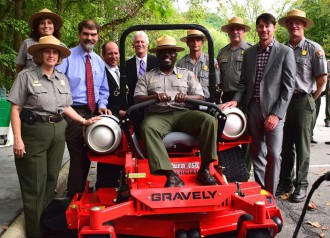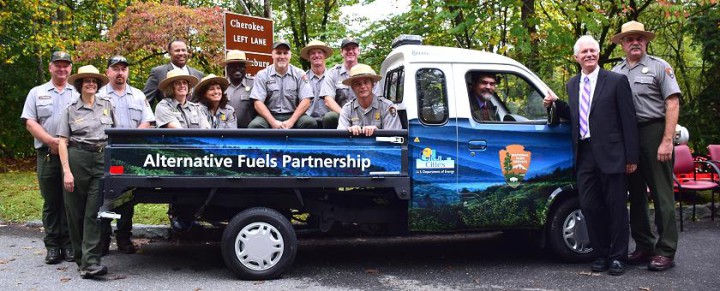The Great Smoky Mountains National Park recently unveiled its new fleet of alternative fuel equipment for staff and park visitors in two ribbon-cutting ceremonies Wednesday at its Oconaluftee Visitor Center near Cherokee, N.C. and Sugarlands Visitor Center near Gatlinburg, T.N., according to a press release from the park.
The official ceremonies marked the park’s completion of the National Park Service’s “Climate Friendly Parks” program, which aims to reduce emissions and improve air quality around the park, in coordination with the U.S. Departments of Interior (DOI) and Energy (DOE), regionally-based East Tennessee Clean Fuels Coalition (ETCleanFuels) and the Land-of-Sky Clean Vehicles Coalition and the Nissan Motor Vehicle Company.
“We really enjoy doing anything we can to help the Smokies,” ETCleanFuels Director Jonathan Overly announced Wednesday. “We are even more proud of this partnership now that we have enabled Smokies’ visitors to get in the game by using the EV charging equipment, or even reducing their idling time.”

The new equipment and installations around the 522,419-acre national park include five gasoline mowers converted to run off propane, which will be used in maintaining visitor center areas, road ways and fields around Cades Cove.
In addition, three new low-speed electric vehicles have been purchased for localized park use around campground areas, which will replace older gasoline-powered vehicles, lowering carbon emissions and improving fuel efficiency.
Electric vehicle recharging stations have been installed at both the Oconaluftee and Sugarland visitor centers, utilizing 220V “Level 2” charging and 208V “DC Fast Charging” systems, which park officials hope will encourage visitors with electric vehicles to enjoy more mobility in the park while further reducing emissions. Extra signage around parking areas has also been put in place, advising visitors to reduce idling in parking areas when applicable.
The Great Smoky Mountains National Park is the first unit in the National Park Service to implement public DC fast-charging stations, according to the press release.
“Putting this equipment in use will help us meet our goal of reducing our greenhouse gas emissions from 2006 levels by 20% by 2020,” said Park Superintendent Cassius Cash during the ceremony. “You will hear more from us in 2016—the 100th anniversary of the National Park System—on our continued efforts towards this goal.”
Several park officials and coalition members shared brief remarks and answered questions from the public, including Cash, Land of Sky Clean Vehicles Coalition Coordinator Bill Eaker and Great Smoky Mountains Association Executive Director Terry Maddox. In addition, representatives of U.S. Senators Richard Burr, Thom Tillis and Nissan were in attendance.
“Air quality has greatly improved in the park and region due to emission reductions from power plants, industries and motor vehicles,” says Eaker. “The Park is a clean transportation leader within the National Park Service and is setting a great example for other parks and fleets across the nation. We are thrilled to be a part of this partnership.”

The “Climate Friendly Parks program” is part of a nationwide “Clean Cities National Park Initiative,” jointly funded by the Department of the Interior and Department of Energy. The initiative seeks to assist national parks in reducing greenhouse gas emissions from park operations and maintenance vehicles and improve park air quality across the country.
For more information on the new equipment at Great Smoky Mountains National Park, visit nps.gov/grsm, cleanvehiclescoalition.org or etcleanfuels.org. To learn more about the U.S. Department of Energy Clean Cities National Parks Initiative, visit www1.eere.energy.gov or see the official press release below.
Press release:
Great Smoky Mountains National Park Celebrates New Alternative Fuel Equipment for Use by Park and Visitors
GRSM Becomes First National Park to Install Public Electric Vehicle Fast Charging Equipment
Gatlinburg, TN – On September 30, 2015, the Great Smoky Mountains National Park (GRSM) held not one but two ribbon-cutting ceremonies to unveil over 10 new pieces of alternative fuel equipment. The events were held at Oconaluftee Visitor Center near Cherokee in North Carolina and at Sugarlands Visitor Center near Gatlinburg in Tennessee.GRSM has completed the implementation of three new facets of the Park’s Climate Friendly Parks program, with funding from a joint U.S. Departments of Interior (DOI) and Energy (DOE) initiative called the “Clean Cities National Park Initiative.” And in this case the new equipment does not just help the Park leave a smaller footprint – it allows the public to join in the effort.
In partnership with its two neighboring DOE “Clean Cities” coalitions—the East Tennessee Clean Fuels Coalition (ETCleanFuels) and the Land-of-Sky Clean Vehicles Coalition—GRSM has put in use these new pieces of equipment to improve air quality in the Smokies:
• Five gasoline mowers were converted to run on propane autogas – These mowers operate near visitors on a regular basis as they mow diverse areas from along roadways to fields in Cades Cove. Additionally, the new mowers performed so well over the summer that the Park has already purchased two additional propane mowers. All of these mowers now run exclusively on propane.
• Three new low-speed electric vehicles for localized use – These vehicles replaced larger gasoline vehicles and emit no pollution at the tailpipe in the Park. The vehicles are mostly providing service in campground areas like Smokemont and Elkmont, as well as in Cades Cove. These vehicles’ fuel economy goes from around 20 MPG to over 100 MPGe (equivalent).
• Two kinds of electric vehicle (EV) recharging equipment were installed on both sides of the Smokies – Both 220V “Level 2” charging and 208V “DC Fast Charging” (DCFC) equipment have been added at Sugarlands and Oconaluftee Visitor Centers to allow visitors with EVs to enjoy more mobility within the Park while creating zero tailpipe emissions. Future Park EVs will also be able to utilize this equipment for their own recharging needs.
GRSM Superintendant Cassius Cash said during the event, “Putting this equipment in use will help us meet our goal of reducing our greenhouse gas emissions from 2006 levels by 20% by 2020, and you will hear more from us in 2016—the 100th anniversary of the National Park System—on our continued efforts towards this goal.”
ETCleanFuels Director Jonathan Overly noted, “We really enjoy doing anything we can to help the Smokies. We are even more proud of this partnership now that we have enabled Smokies’ visitors to get in the game by using the EV charging equipment, or even reducing their idling time.” Overly is referring to the addition of some signage in certain parking areas requesting that visitors not idle their personal vehicles unless necessary.
Bill Eaker, Coordinator of the Land of Sky Clean Vehicles Coalition said “Air quality has greatly improved in the park and region due to emission reductions from power plants, industries and motor vehicles. The Park is a clean transportation leader within the National Park Service and is setting a great example for other parks and fleets across the nation. We are thrilled to be a part of this partnership.”
The joint DOI/DOE funding is helping multiple national parks across the country advance their goals towards reducing greenhouse gas emissions from park operations and maintenance vehicles and improving air quality overall in and around the parks. Learn more here: http://www1.eere.energy.gov/cleancities/national_parks.html



Before you comment
The comments section is here to provide a platform for civil dialogue on the issues we face together as a local community. Xpress is committed to offering this platform for all voices, but when the tone of the discussion gets nasty or strays off topic, we believe many people choose not to participate. Xpress editors are determined to moderate comments to ensure a constructive interchange is maintained. All comments judged not to be in keeping with the spirit of civil discourse will be removed and repeat violators will be banned. See here for our terms of service. Thank you for being part of this effort to promote respectful discussion.